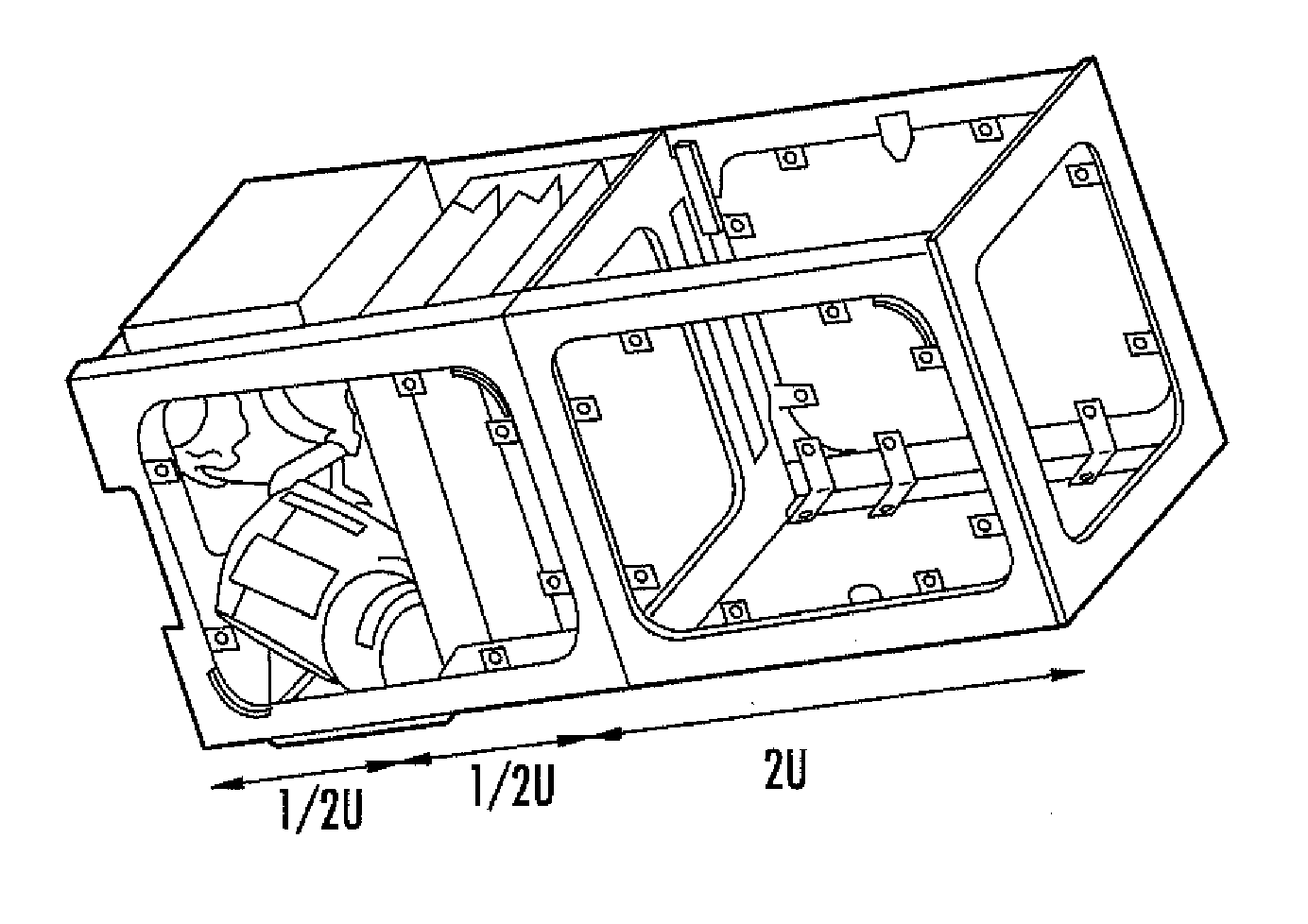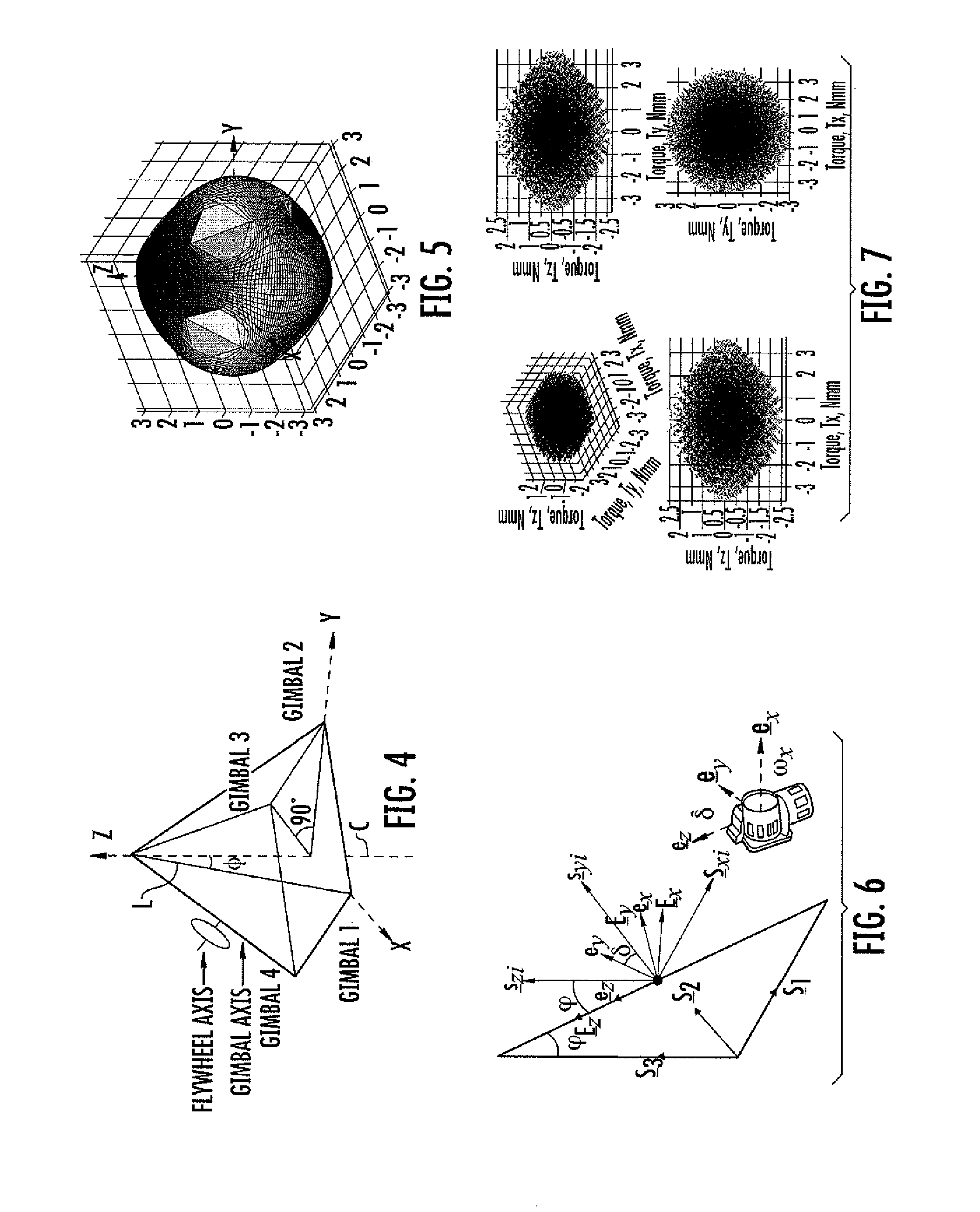Attitude control system for small satellites
a satellite and attitude control technology, applied in the field of satellites, can solve the problems of enormous amount of money and effort, failure of traditional satellites, and very little room for innovation, and achieve the effects of avoiding the maintenance of outdated techniques and procedures, and avoiding the development of redundant systems
- Summary
- Abstract
- Description
- Claims
- Application Information
AI Technical Summary
Benefits of technology
Problems solved by technology
Method used
Image
Examples
first embodiment
[0126]The SGCMG 10 generally includes a flywheel assembly 12, a gimbal assembly 14, and a slip ring assembly 16, as shown in FIGS. 12-14. One particular purpose of the flywheel assembly 12 is to accommodate components required to spin a rotor at high speeds (e.g., 5000 rpm). The flywheel assembly 12 generally includes:[0127]Flywheel housing (36)[0128]Motor (rotor+stator) (32)[0129]Bearings (34)[0130]Snap rings (35)[0131]Flywheel (shaft+endpiece) (30)
[0132]One function of the flywheel assembly 12 is to accommodate a spinning flywheel 30 and its motor 32 that provide the required angular momentum to the SGCMG. The flywheel assembly 12 also provides an interface to the gimbal assembly 14. An exploded view of the flywheel assembly is shown in FIG. 15, which illustrates the flywheel 30 with the motor rotor (magnet) 37 is mountable on a pair of bearings 34 and capable of being disposed within a flywheel housing 36. The flywheel 30 is driven by a brushless DC motor w...
second embodiment
[0160]A second embodiment of a SGCMG 100 is shown in FIGS. 19-20. Generally, the SGCMG 100 includes:
[0161]a) Flywheel housing (136)
[0162]b) Flywheels (130)
[0163]c) Flywheel motor (132)
[0164]d) Flywheel bearings (134)
[0165]e) Flexible couplings (135)
[0166]f) Flywheel motor control boards (137)
[0167]g) L-bracket (150)
[0168]h) Gimbal motor mount plate (152)
[0169]i) Gimbal bearings (156)
[0170]j) Gimbal motor with integrated encoder (154)
[0171]k) Slip ring assembly (116)
The first six components form the flywheel assembly 112 while the remaining components form the gimbal assembly 114.
Flywheel Assembly
[0172]An exploded view of the flywheel assembly 112 is shown in FIG. 21. The construction of the flywheel housing 136 is similar to the flywheel housing 36 described above but with some modifications to accommodate the new motor 132 and flywheels 130. The SGCMG 100 is smaller in size, accommodates two flywheels 130 and has a central plate for the motor mount. The flywheel motor 132 is face m...
third embodiment
[0193]A third embodiment of a SGCMG 200 is shown in FIG. 35, which is a hybrid of the SGCMGs 10, 100 discussed above. The SGCMG 200 was considered to produce more torque for using them in larger satellites (e.g., nano-satellites) [12]. The mass and volume constraints of 500 g and ½ U were still considered applicable. But the power constraint of 3 W was relaxed assuming more power availability in larger satellites. A frameless motor 232, such as a Kollmorgen motor, was again considered for the flywheel assembly 212, while a brushed DC gear motor 254, such as the Micromo 2619 series DC gear motor, was used for the gimbal assembly 214.
[0194]The following are the specifications of the hybrid design:
[0195]1. Mass: <500 g
[0196]2. Volume: ½ U (100×100×50 mm3)
[0197]3. Power: 6 W
[0198]4. Flywheel speed: 10000 rpm
[0199]5. Maximum gimbal speed: 1 rad / s
[0200]6. Torque: 3 Nmm
[0201]The torque produced by SGCMG 200 is sufficient for the ACS of a nano satellite whose mass is less than 12 Kg and occ...
PUM
 Login to View More
Login to View More Abstract
Description
Claims
Application Information
 Login to View More
Login to View More - R&D
- Intellectual Property
- Life Sciences
- Materials
- Tech Scout
- Unparalleled Data Quality
- Higher Quality Content
- 60% Fewer Hallucinations
Browse by: Latest US Patents, China's latest patents, Technical Efficacy Thesaurus, Application Domain, Technology Topic, Popular Technical Reports.
© 2025 PatSnap. All rights reserved.Legal|Privacy policy|Modern Slavery Act Transparency Statement|Sitemap|About US| Contact US: help@patsnap.com



